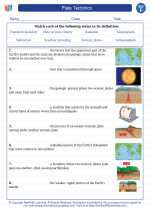Plate Boundaries
Plate boundaries are the areas where tectonic plates meet. There are three main types of plate boundaries: convergent, divergent, and transform boundaries.
Convergent Boundaries
Convergent boundaries occur when two tectonic plates move towards each other. There are three types of convergent boundaries: oceanic-continental, oceanic-oceanic, and continental-continental. When an oceanic plate collides with a continental plate, the denser oceanic plate is subducted beneath the continental plate, forming deep ocean trenches and volcanic mountain ranges. When two oceanic plates converge, one is subducted beneath the other, leading to the formation of volcanic island arcs. In the case of continental-continental convergence, the plates crumple and fold, creating large mountain ranges.
Divergent Boundaries
Divergent boundaries occur when two tectonic plates move away from each other. This movement allows magma from the mantle to rise up and create new crust. Divergent boundaries are often found along mid-ocean ridges, where new oceanic crust is formed as the plates pull apart.
Transform Boundaries
Transform boundaries occur when two tectonic plates slide past each other horizontally. The movement along these boundaries is typically characterized by earthquakes, as the plates are locked together and then suddenly release their built-up energy. The most well-known example of a transform boundary is the San Andreas Fault in California.
Study Guide
- What are the three main types of plate boundaries? Convergent, divergent, and transform boundaries.
- Describe the process that occurs at a convergent boundary between an oceanic plate and a continental plate. The oceanic plate is subducted beneath the continental plate, forming deep ocean trenches and volcanic mountain ranges.
- What landform is created at a divergent boundary on land? A rift valley or ridge.
- What type of movement characterizes a transform boundary? Horizontal sliding past each other.
◂Science Worksheets and Study Guides Sixth Grade. Plate Tectonics

 Worksheet/Answer key
Worksheet/Answer key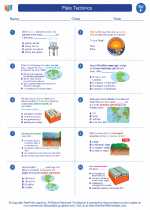
 Worksheet/Answer key
Worksheet/Answer key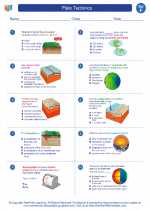
 Vocabulary/Answer key
Vocabulary/Answer key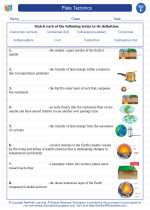
 Vocabulary/Answer key
Vocabulary/Answer key
 Vocabulary/Answer key
Vocabulary/Answer key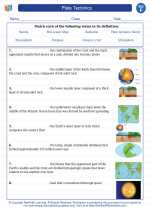
 Vocabulary/Answer key
Vocabulary/Answer key